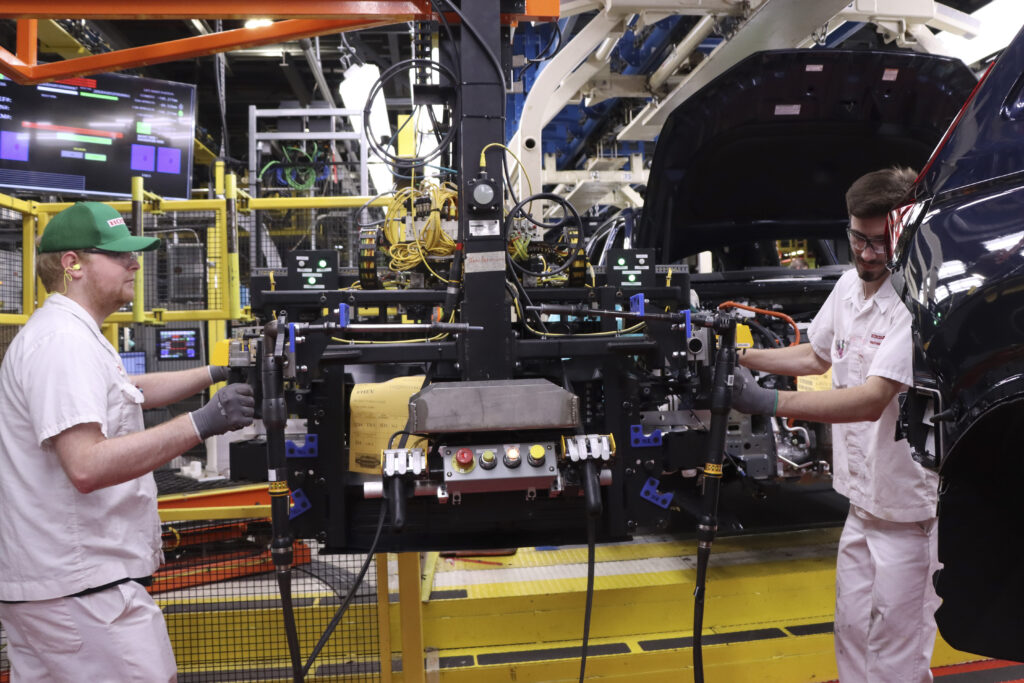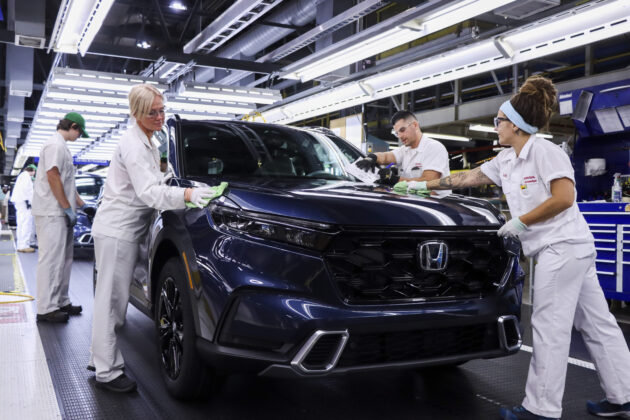
Future-proof facilities: How Honda retools its plants
May 23, 2023
By Jack Kazmierski
Continuous improvements in efficiency, product quality and worker safety are all part of the bigger picture when Honda retools a plant.
 A major challenge when retooling a plant is minimizing the impact any changes will have on assembly line workers. (Photo: Honda)
A major challenge when retooling a plant is minimizing the impact any changes will have on assembly line workers. (Photo: Honda) Honda recently retooled part of its Alliston plant in order to manufacture the 2023 CR-V Hybrid. The plant will continue to build the Civic, the gas-powered CR-V, as well as Honda engines, but the addition of the Hybrid called for an upgrade to the assembly line at the plant.
“We don’t really retool in the sense of ripping everything out and putting in new equipment,” explains Ioan Buzdugan, engineering lead/equipment safety lead at Honda of Canada Mfg. “We basically try and reuse as much of our existing equipment as possible, and then we add and modify, as necessary.”
Buzdugan says that retooling for the new Hybrid model included new fixtures, new lift assists, as well as modifying existing automated cells, rearranging processes on the line, adding new robots to existing lines, extending conveyor lines and adding new conveyors for sub-assembly to accommodate new parts of the power unit.
The Alliston plant is highly automated, but Honda still employs thousands of workers. This means that all the processes needed to build the new Hybrid model had to be adjusted for the humans involved in the process.
In addition to retooling specifically for the new CR-V Hybrid model, Honda also implemented improvements to the plant as part of the company’s ongoing commitment to continuous improvements in efficiency, product quality and worker safety.
Man and machine
In order to improve the collaboration between man and machine, and to limit future expenses whenever the assembly line will need to be updated for a new model, Honda employed robots with power force limiting capabilities.
“We’re starting to look at where we can apply these robots to improve the flexibility of our lines,” Buzdugan adds. “If we don’t need to put up as many fences as we would on a traditional robot line, that increases the flexibility. When we have to prepare the line for a new model, if we have to arrange processes around the robot, it’s easier and potentially less expensive to do so if we don’t have a lot of fences or light curtains to deal with.”
Honda is using these same types of robots to reduce the amount of non-value-added work employees have to do. “We want our associates to spend their time with their hands on the car, doing things that actually add value, and not walking around moving parts,” Buzdugan explains. “We’re looking at how we can use robots with power force limiting in the process area to do some simple sub-assembly work, and then present the finished part to an associate who wouldn’t have to walk to different part bins to get the parts himself.”
In their quest for constant improvement, Honda is looking at ways to use 3D cameras and machine vision to automate inspections, especially when a part may not have been installed in the exact same location, every single time, on a vehicle by a worker. Furthermore, the company is harnessing the power of the Internet-of-Things in order to predict the failure of certain parts used in the manufacturing process, and replace those parts before they fail, thereby reducing downtime.

The addition of the CR-V Hybrid to Honda’s Alliston plant called for an upgrade to the assembly line. (Photo: Honda)
Retooling process
Buzdugan says that Honda has over 300 engineers and technicians working at their plants. When a new car model needs to be built, it’s their job to figure out what needs to happen to make that possible. “When we receive the design for a new model, our team analyzes the changes, analyzes the current situation of our equipment, and then they identity the gap to determine what has to be changed or added,” he explains. “We try to reuse as much of the current line as possible, instead of just ripping it out and putting a new one in. So, their job is to analyze the existing automation, determine what we have to change, as well as look for opportunities to automate, where possible.”
Honda employs both internal and external integrators to get a line ready for a new vehicle. “We prepare specifications for what we need, determine the cycle time, what quality inspections are needed, and what the safety requirements will be,” Buzdugan says. “Our engineers do a layout, and then we get either external integrators or our internal integration group to build that equipment and test it. Then our on-site engineers commission it and get it running.”
Although Honda’s engineering team will often design and build the equipment necessary for retooling, sometimes the company will recruit outside help. “If there is a piece of equipment that’s very specialized, that an outside company makes, then we’ll buy it from them,” Buzdugan explains, “but we’ll have our engineers integrate it into our existing line, and test it to make sure it meets our standards.”
The process of retooling a plant can take years. It’s often a longer process for a brand-new model, than for a vehicle like the CR-V Hybrid, which is based on the current CR-V model.
Worker training
One of the major challenges when retooling a plant is minimizing the impact any changes will have on the assembly line workers and other associates. “We try to keep the way they interface with the automation as consistent as possible,” Buzdugan explains. “We consider everything, including how they will interact with things like the touchscreens. We can change the automation, but if we make the interface similar to what they’re used to, that helps.”
Training assembly line associates can take weeks. “There’s a significant process that production associates go through to train for new models, because of all the process changes,” Buzdugan adds. “But then there’s all the technical training for our equipment, services and maintenance associates. We have an internal technical training centre, inside our facility, where we have experienced associates going through courses on technical topics like robots, PLCs and more.”
Planning for the future, Honda also brings training to schools, with the aim of teaching the next generation of technicians. “Our goal is to be proactive,” Buzdugan says, “so we work with universities and colleges where the faculty, along with mentors from Honda Canada Manufacturing train students on the automation technologies we use in our plant. When we hire candidates, we’d like them to already know a lot about the technologies we use.”
Whenever an upgrade or an update to a plant is needed, Honda plans the retooling process with the future in mind. Continuous improvement is a key concern, as is future-proofing the facility. “We like to set ourselves up for future success,” Buzdugan concludes. “Within reason, we want to assure that we have the flexibility to take on future models, or future variation of existing models while staying focused on key elements like efficiency, product quality and worker safety.”
Advertisement
- Beckhoff Automation’s EtherCAT completes 20 years
- NGen launches $19M ‘Future Ready’ workforce transformation program with ESDC support